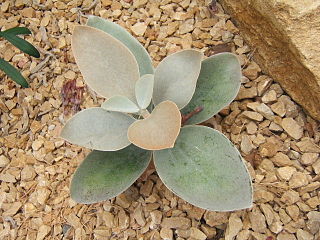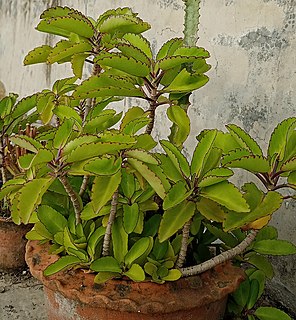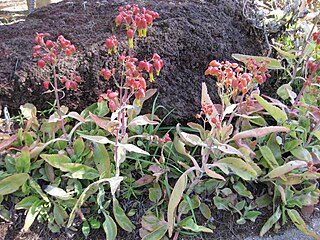
The Saxifragales (saxifrages) are an order of flowering plants (Angiosperms). They are an extremely diverse group of plants which include trees, shrubs, perennial herbs, succulent and aquatic plants. The degree of diversity in terms of vegetative and floral features makes it difficult to define common features that unify the order.

The Crassulaceae, also known as the stonecrop family or the orpine family, are a diverse family of dicotyledon flowering plants characterized by succulent leaves and a unique form of photosynthesis, known as Crassulacean acid metabolism (CAM). Flowers generally have five floral parts. Crassulaceae are usually herbaceous but there are some subshrubs, and relatively few treelike or aquatic plants. Crassulaceae are a medium size monophyletic family in the core eudicots, among the order Saxifragales, whose diversity has made infrafamilial classification very difficult. The family includes approximately 1,400 species and 34–35 genera, depending on the circumscription of the genus Sedum, and distributed over three subfamilies. Members of the Crassulaceae are found worldwide, but mostly in the Northern Hemisphere and southern Africa, typically in dry and/or cold areas where water may be scarce, although a few are aquatic.

KalanchoeKAL-ən-KOH-ee, also written Kalanchöe or Kalanchoë, is a genus of about 125 species of tropical, succulent plants in the stonecrop family Crassulaceae, mainly native to Madagascar and tropical Africa. A Kalanchoe species was one of the first plants to be sent into space, sent on a resupply to the Soviet Salyut 1 space station in 1979. Kalanchoes require direct sunlight although they can survive with bright indirect sunlight. They only need to be watered when the soil is completely dry.

Kalanchoe orgyalis a species of flowering plant in the Crassulaceae family. It is a succulent commonly known as copper spoons due to its leaf shape.

Bryophyllum is a group of plant species of the family Crassulaceae native to Madagascar. It is a section or subgenus within the genus Kalanchoe, and was formerly placed at the level of genus. This section is notable for vegetatively growing small plantlets on the fringes of the leaves; these eventually drop off and root. These plantlets arise from mitosis of meristematic-type tissue in notches in the leaves.

Kalanchoe daigremontiana, formerly known as Bryophyllum daigremontianum and commonly called mother of thousands, alligator plant, or Mexican hat plant is a succulent plant native to Madagascar. Like other members of Bryophyllum, it can propagate vegetatively from plantlets that develop on its leaf margins. All parts of this species contain a very toxic steroid known as daigremontianin.

Kalanchoe thyrsiflora is a species of flowering plant native to Botswana, Lesotho, South Africa and Swaziland.

Kalanchoe blossfeldiana is a herbaceous and commonly cultivated house plant of the genus Kalanchoe native to Madagascar. It is known by the English common names flaming Katy, Christmas kalanchoe, florist kalanchoe and Madagascar widow's-thrill.

Kalanchoe robusta is a species of plant in the family Crassulaceae. It is endemic to the Yemeni island of Socotra. Its natural habitat is on rocky slopes and amongst limestone boulders in dwarf shrubland and low succulent shrubland at an altitude of 300–750m. While it is listed by IUCN as belonging to the order Rosales, Kalanchoes and other Crassulaceae are more usually placed in Saxifragales.

Kalanchoe pinnata, formerly known as Bryophyllum pinnatum, also known as the air plant, cathedral bells, life plant, miracle leaf, and Goethe plant is a succulent plant native to Madagascar, which is a popular houseplant and has become naturalized in tropical and subtropical areas. It is distinctive for the profusion of miniature plantlets that form on the margins of its phylloclades, a trait it has in common with some other members of Bryophyllum.

Kalanchoe rhombopilosa is a succulent plant species in the family Crassulaceae. This species of plant is endemic to southwest Itampolo, Madagascar. The species was described by Mannoni & Boiteau in 1947 and is indexed in Notul. Syst. (Paris) 13:153-154, (1947). The plant is a herbaceous perennial that grows to 10–20 cm in height.

Kalanchoe gastonis-bonnieri is a species of flowering plant in the family Crassulaceae. They are called "palm beachbells" or "donkey ear plants" as they have leaves resembling the shape of a donkey's ear.

Kalanchoe manginii, beach bells, is a species of flowering plant in the family Crassulaceae, native to Madagascar. It is an evergreen succulent perennial growing to 30 cm (12 in) tall and wide, with arching branches of rounded, glossy leaves, and urn-shaped salmon-red flowers in spring. As the minimum temperature for growth is 10 °C (50 °F), in temperate regions this plant must be grown under glass as a houseplant.
Kalanchoe fadeniorum is a species of Kalanchoe in the family Crassulaceae.

Kalanchoe longiflora, also known as tugela cliff-kalanchoe or long-flower kalanchoe, is a species of the succulent genus Kalanchoe, in the family Crassulaceae. An obscure shrub native to South Africa, it is known for its multi-coloured foliage and yellow flowers, which bloom in autumn to winter.

Kalanchoe garambiensis is a plant species in the succulent genus Kalanchoe, and the family Crassulaceae. It is endemic to Taiwan.

Kalanchoe × poincarei is a species of Kalanchoe native to southern Madagascar. Its scientific name is often misapplied to K. suarezensis and K. mortagei, but K. × poincarei is very different from them. The true K. × poincarei is a natural hybrid involving K. beauverdii, with similar sprawling stems up to 3 m in length, and not known in cultivation, whereas K. suarezensis and K. mortagei are erect, 30~60 cm tall and cultivated as ornamentals.

Kalanchoe suarezensis is a species of Kalanchoe native to northern Madagascar.
Kalanchoe mortagei is a species of Kalanchoe native to northern Madagascar. It is very similar to K. suarezensis, and both of them used to be mistakenly treated as varieties of a totally different species K. poincarei. K. mortagei differs by having auriculate to peltate leaves, while the leaf base of K. suarezensis is attenuate to truncate.

Kalanchoe beauverdii is a species of flowering plant in the family Crassulaceae. It goes by the common name Beauverd's widow's-thrill.



















